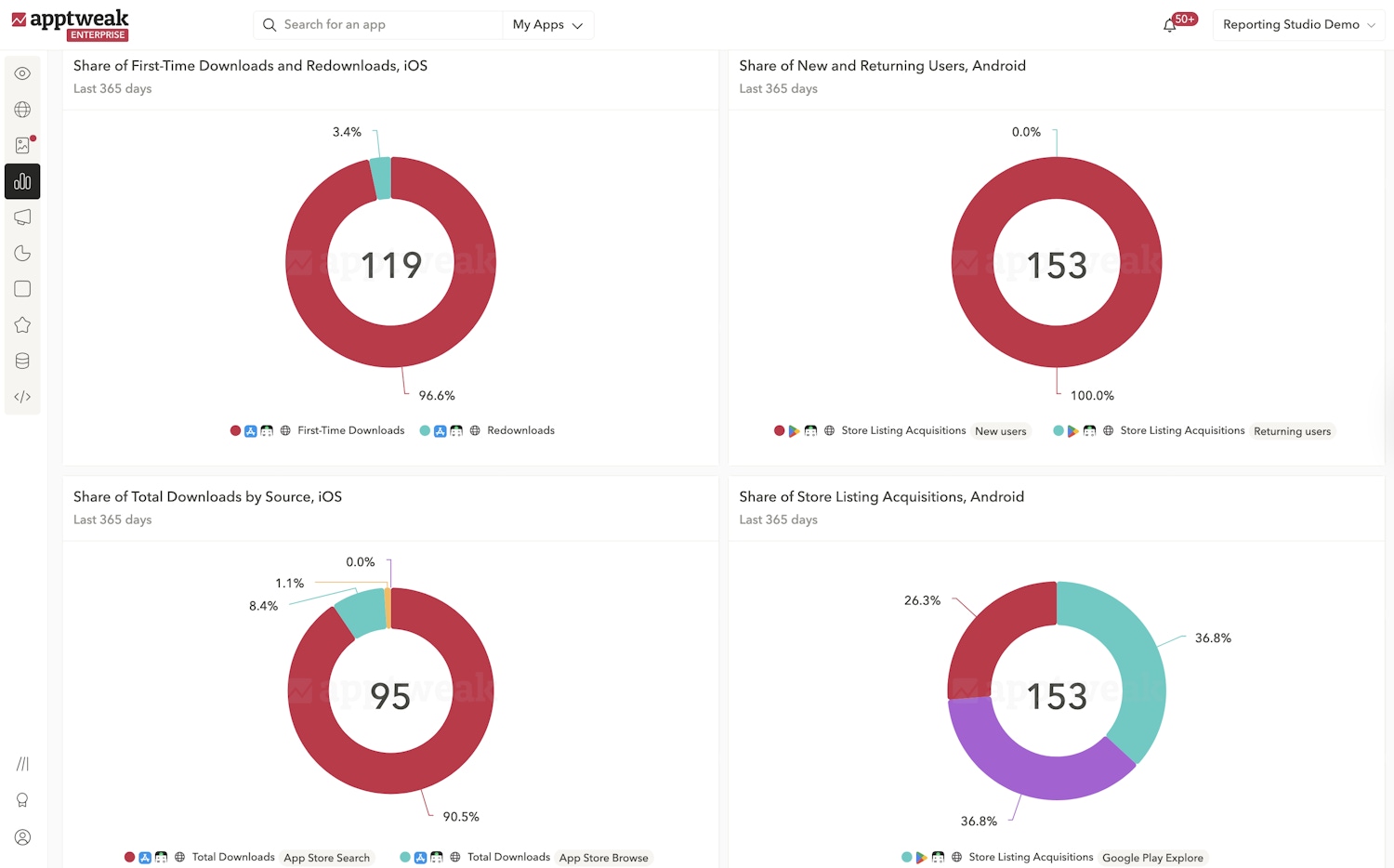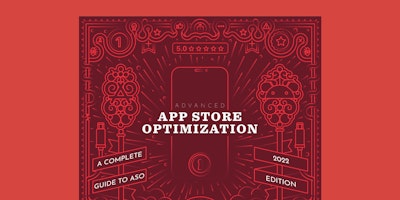
Must-have dashboards for app store marketing and ASO
Reporting isn’t supposed to slow you down. It should show you what’s working, what’s not, and where to act – fast.
But even AppTweak’s own consultants, working with the world’s top apps and games, used to spend hours building Looker dashboards, fixing broken exports, and rebuilding reports from scratch whenever something changed.
And once the data was ready, they still had to figure out what it actually meant.
That’s why we built Reporting Studio. In one place, mobile marketing teams can monitor performance and make sense of their data, without relying on spreadsheets or disconnected tools.
Below, we highlight the most useful dashboards for ASO and growth teams based on the reports our consultants build daily. For each one, we’ll explain who it’s for and the key metrics to track, with expert tips from AppTweak’s Head of ASO & Market Insights, Simon Thillay.
The challenge with app store reporting today
App marketers aren’t short on data. But different teams track different metrics, use different tools, and define success in different ways. This often leads to misalignment, slow reporting, and confusion about what’s really driving growth.
Reporting Studio helps you cut through the noise:
- Centralize App Store, Google Play, and MMP data in shared workspaces
- Share public or private dashboards with external links
- Get started in seconds with pre-built templates
The four dashboards every app store marketing team needs
Each dashboard template in Reporting Studio reflects our years of consulting experience. They’re designed to help real teams report efficiently, align cross-functionally, and make faster decisions.
All you need to do is connect your console. The dashboards build themselves – and from there, they’re yours to customize. We’d always suggest adding extra reports, data sources, or custom metrics to match how your team works.

🎥 Watch the replay of Office Hours: Mastering ASO Dashboards for more reporting tips and tricks
1. ASO Manager Dashboard: Monitor the metrics you influence
Best for: ASO specialists managing metadata, creatives, and app store performance.
Purpose: This dashboard tracks the metrics ASO teams can influence – how well you’re attracting and converting organic traffic in the store.

Key reports and what they tell you:
- Downloads from search + browse/explore: The first question an ASO manager gets is often, “How many downloads came from your work?” Start this dashboard by tracking core organic performance.
- Download share by source: Understand how much of your total installs come from organic. A drop may signal another channel growing faster or a real decline in organic.
- Impression share by source: Compare traffic share (impressions) to install share. High organic impressions but low installs could indicate low conversion.
- Conversion rate by source: Remember that conversion = installs ÷ impressions. Use these reports together to identify potential issues with your strategy.
Expert Tip
On Google Play, the line between “search” and “explore” can be blurry, as some keywords from search results are labeled as “explore.” Combining downloads from both sources will help you avoid misreading performance.2. Head of Growth Dashboard: Track acquisition & monetization
Best for: Growth leads, UA managers, and performance marketers
Purpose: Support cross-functional conversations about different acquisition channels and user types, and how they impact installs and revenue.

Key reports and what they tell you:
- Share of store vs. external downloads: Monitor how much of your growth comes from within the app stores vs external campaigns.
- Share of new vs. returning users: Understand user mix. There’s no “best” ratio here: early-stage apps should prioritize first-time installs; mature apps often drive more redownloads.
- Download share by source: Align UA and ASO teams on where growth is coming from and where you want to scale efforts.
- Downloads vs. sales: If installs are growing but revenue isn’t, assess whether it’s an expected part of your strategy or if you’re acquiring fewer high-value customers.
Expert Tip
Add MMP data to this dashboard to drill into campaign performance. Instead of seeing generic “referral” traffic, you’ll get deeper insight into how much traffic came from TikTok, Meta, or specific ad networks.3. Executive Dashboard: Provide clear, strategic performance insights
Best for: CMOs, VPs, and cross-functional leadership
Purpose: Leadership doesn’t want every metric – they want direction. This dashboard highlights overall performance, key trends, and areas to investigate further.

Key reports and what they tell you:
- Total downloads on both stores: Get the big picture of your performance across both stores combined and spot unusual spikes or drops.
- Download trends and share: Understand how each store contributes to growth. Useful for setting OKRs or adjusting budgets.
- Performance overview: Track whether growth comes from more visibility (impressions), a lift in installs, or better conversions.
- Store vs external downloads: Spot shifts between ASO and paid UA performance.
Expert Tip
Tailor your dashboards with custom metrics. For example, if you want to isolate pure “organic” installs from the App Store, add up search + browse, or subtract Apple Ads installs from total search installs.4. Competitive Analysis Dashboard: Benchmark against the market
Best for: ASO teams, UA leads, and product marketers tracking competitors
Purpose: Growth isn’t just about your own numbers. While the first three dashboards rely on your console data, this dashboard is powered by accurate mobile market intelligence. It’s ideal for monitoring competitor trends that could later affect your growth.

Key reports and what they tell you:
- Download and revenue trends: Spot changes in competitors’ downloads and revenue performance early.
- Download and revenue growth: Compare how fast you’re growing vs competitors in key markets.
- Download and revenue share: Know who dominates market share over time.
Expert Tip
If a competitor’s performance spikes, check for updates, localizations, or new market launches. You could also analyze the maximum reach (impressions) of their brand keywords to keep tabs on popularity.How to use dashboards for app store reporting
There are two main approaches to app store reporting. Reporting Studio supports both.
- Monitoring: Track the same KPIs regularly to catch changes fast. Each dashboard template is built for this kind of daily health check, just like scanning your inbox in the morning.
- Investigating: When performance shifts, it’s time to dig. Duplicate a dashboard or report, adjust filters, metrics, or data sources to find out the ‘why’.
Monitoring helps you catch changes early. Investigating tells you what’s causing them.
Avoid these common reporting mistakes
Many teams fall into the same traps when reporting on app store performance. Here’s how you can avoid them (and save your team hours):
- Reporting in isolation: If your dashboard only makes sense to you, it won’t drive action. Use fewer acronyms, include relevant context, and keep the story clear.
- Too many reports, too little insight: More isn’t always better. Stick to essential reports that support decisions – then add depth as needed.
- Misunderstanding metrics: Not all data points are calculated the same way. For example, Apple Ads reports total impressions, while App Store Connect reports unique impressions. Subtracting one from the other might seem logical but could distort your analysis.
- Assuming everyone speaks the same language: “Organic” or “referral” might mean different things to your ASO and UA teams. Use dashboards as an opportunity to align on terminology and methodology. When in doubt, show trends across multiple sources.
Conclusion
Reporting should help you answer questions, not create more of them. If a dashboard doesn’t lead to action, ask yourself:
- Am I tracking the right metrics?
- Is it relevant to my audience?
- Does the data tell a story, or just fill space?
With Reporting Studio, you can build dashboards that help you align on real app performance goals. Use templates to get started, customize them as you grow, collaborate across teams, and feel confident proving your impact.



 Oriane Ineza
Oriane Ineza

 Micah Motta
Micah Motta
